As part of the celebration of the 70th anniversary of Topps baseball cards, we've asked fans (as well as our staff) to submit their all-time favorite baseball cards, and we've broken them down by team. We'll be revealing submissions regularly throughout the season, ranging from the famous to the weird, and everything in between.
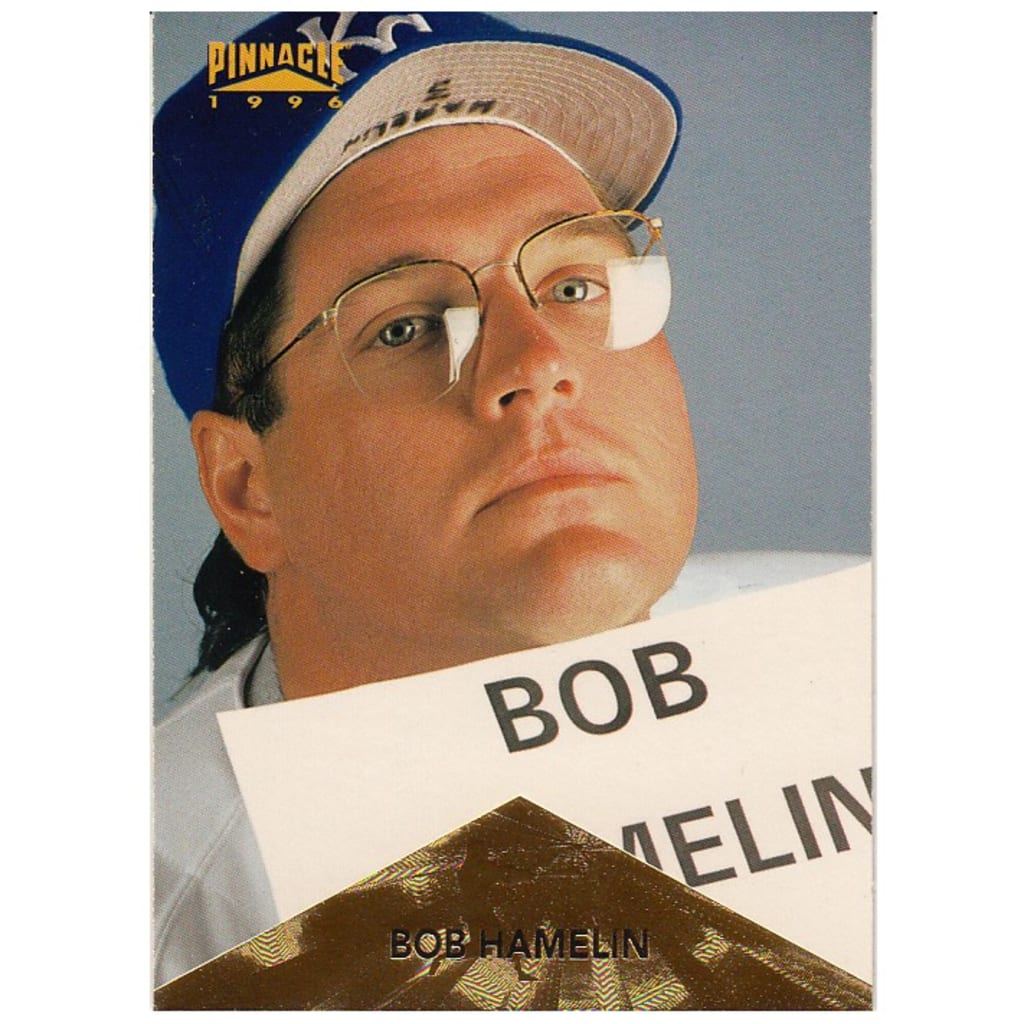
Bob Hamelin, 1996 Pinnacle
File this one in the “so bad it's good” category.
The close-up shot. The blank stare. The huge glasses, reflecting the light. The mullet. The sheet of paper with his name on it.
“This card is amazing in how it ended up looking. Like we can clearly tell it’s Bob Hamelin. What is the picture though? It’s what I’d call a wonderfully inept baseball card, and that’s why it’s my favorite.”
It was also submitted by Sam Rosenbaum of Martinez, California.
“Bob Hamelin's 1996 Pinnacle card holds a special place in the hearts of many people as being the worst baseball card of all time,” Rosenbaum wrote. “I am one of them. The card stands out among many of the ‘worst cards ever’ in that the true horror of the card sets in the longer you look at it, like a frog in a boiling pot of water. Your eyes first notice Bob carrying a piece of paper with his name on it, as if to remind the photographer of who he is. The paper itself is partially obscured by the name on the card, letting you know that it is, in fact, Bob Hamelin you are looking at. Your vision drifts up to Bob himself, and boy, does he look unhappy. The photo is taken at point blank range and Bob appears to be tilting his head slightly to the side in order to fit it all in frame. Little details jump out to you: hey, the light’s reflecting in his glasses; huh, his hat’s got his name on it; wait, which team does this guy play for? Little things like that add up to make this card as truly bad as it is.” -- Thomas Harrigan

Bo Jackson, 1987 Topps
Jackson made his Major League debut in '86, the same year the Royals selected him in the fourth round of the MLB Draft. A 25-game cup of coffee in which he hit just .207 and struck out 34 times in 82 at-bats wasn’t enough to spoil the perception that he was going to be a top player.
Jackson got the “Future Stars” treatment on his '87 Topps card, which depicts the outfielder pursuing a fly ball.
That year proved to be a big one for Jackson, who broke out with 22 homers for the Royals and later made his NFL debut with the Raiders, fulfilling his destiny as a two-sport star.
Jackson’s '87 Topps card was submitted by Chicago’s Clayton Berkey, who wrote:
“Bo was larger than life as a player and has become almost mythical in the decades since his playing days. Bo could do everything: he was fast, he could throw the ball a mile, and he could hit home runs harder and farther than anyone. As kids, my friends and I LOVED Bo. He was just so cool. But he was tough, too, and a little intimidating, though never scary. This card is awesome and is the coolest card in the coolest set from the 1980s. Those wood borders are classic! Look at Bo's concentration and his anticipation. I don't know what happened after this photo was taken, but I bet it was epic!” -- Thomas Harrigan
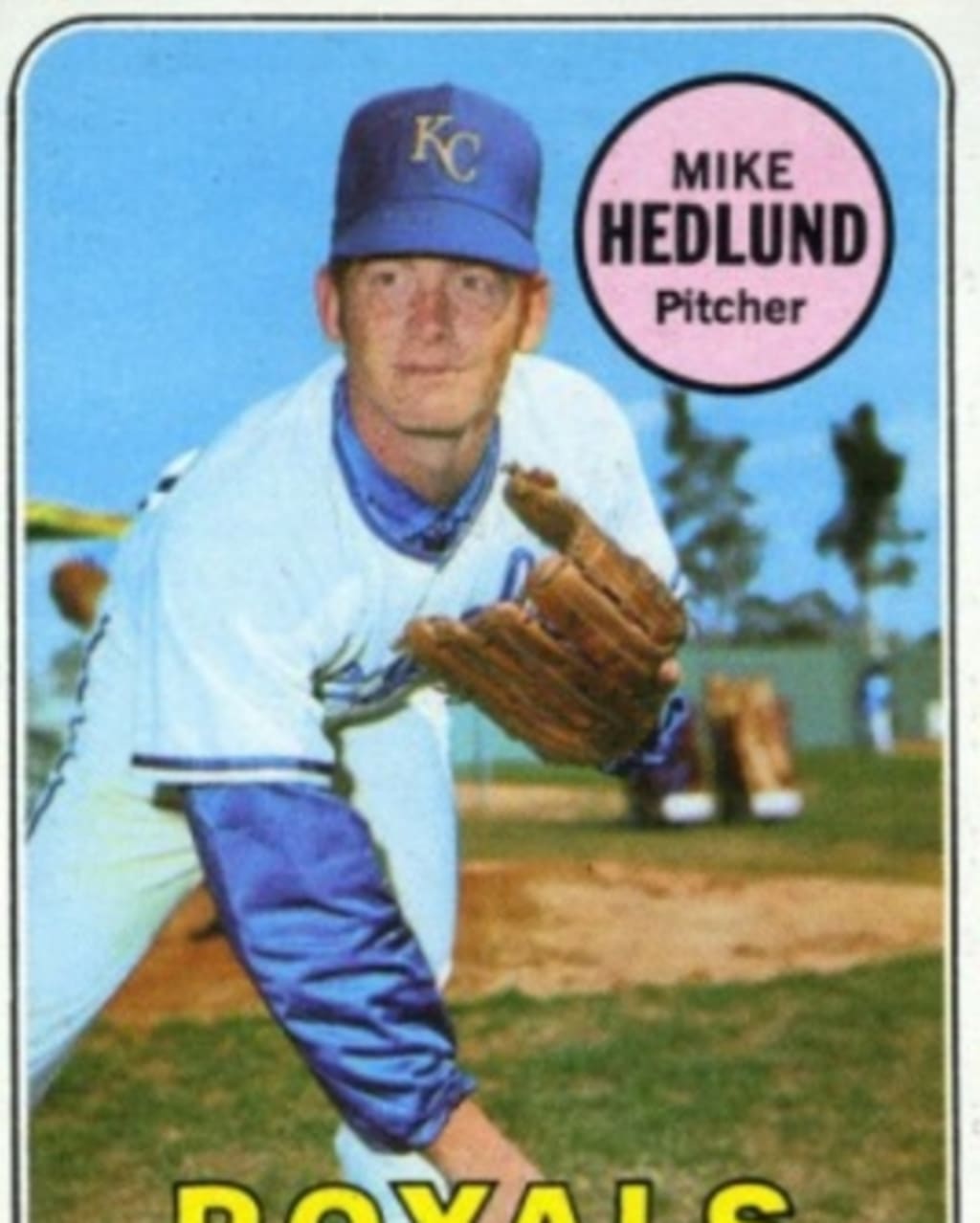
Mike Hedlund -- 1969 Topps
At its heart, baseball is about the people. And this card is a great example of that.
“My favorite card has close and personal ties to me,” wrote Scott H. of Ipswich, South Dakota. “Growing up, I would hear stories about my Dad's cousin, Mike Hedlund. Mike's dad, William ‘Bill’ Hedlund, helped establish the American Legion baseball program in Arlington during the early 1960s, and Mike was an outstanding American Legion player who went on to play for the Cleveland Indians in 1965 and ’68, and the Kansas City Royals from 1969-72.
“My Dad was never a big baseball fan -- unlike me! -- but he kept this card in a frame on his dresser where he could see it every day. He was so proud of his cousin. We lost Dad in August of 2020, but I know he still looked at that card every day until he left us. It’s not a famous card, it's not worth much, but the memories it brings are priceless to me.”
That’s another great part of seeing what people’s favorite cards are -- the stories behind the less famous ones. They give us a great glimpse into what makes baseball so special. -- Manny Randhawa
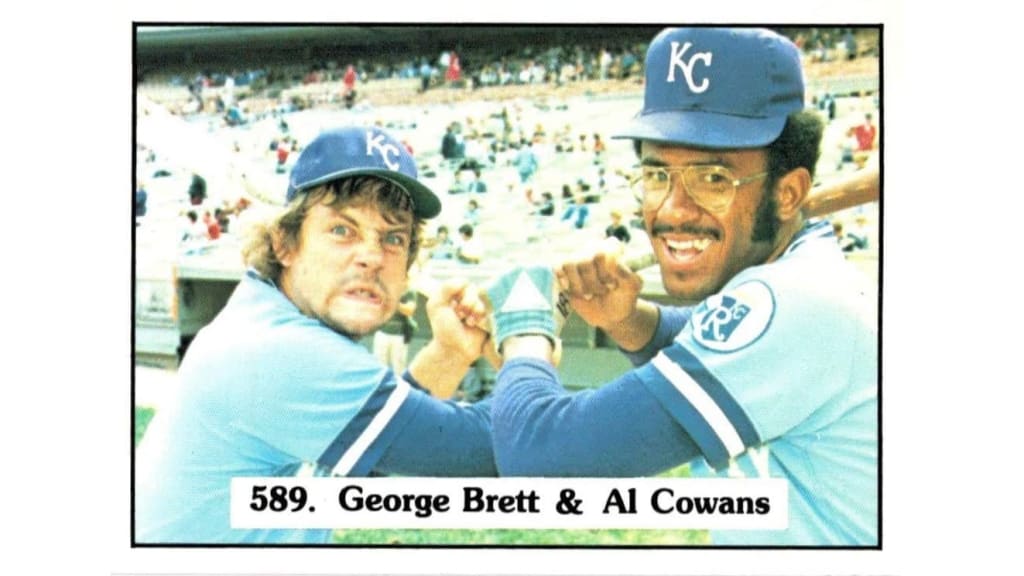
Best Royals facial hair card: George Brett and Al Cowens, 1976 SSPC
Is it possible the makers of this card were so distracted by the sheer awesomeness of this picture that it caused them to misspell Cowens’ last name?
This card features Brett looking like an absolute madman, with a crazed look, wild hair and what appears to be the early stages of a horseshoe mustache.
Cowens counters with a ‘stache of his own, plus big sideburns and even bigger glasses. There’s a lot to unpack here, and all of it is fantastic. -- Thomas Harrigan

George Brett, 1976 Topps
Brett’s expression on his '76 Topps card is one that exudes confidence. Although he was still just 22 years old, this was someone who knew he belonged in the Majors.
After a so-so rookie season in '74, Brett broke out in '75, leading the American League in hits (195) and posting a .308/.353/.456 slash line (125 OPS+) with 11 homers and 90 RBIs in 159 games.
Brett's intense, icy stare was juxtaposed with his carefree, unkempt hairdo. The shaggy-haired look the Hall of Famer had early in his career is one that Kansas City’s Douglas Stark, who submitted this card, tried hard to emulate.
“When I first started collecting cards, I was a kid who played sandlot ball with all the kids in the neighborhood and I put in a lot of effort to not only play like Brett, but look like him [just like this card], with the hair flipping up from under the sides of the cap,” Stark wrote. “It was critical that I had this look, and it took me an entire summer!”
Brett went on to hit .333 in '76, winning his first batting title and finishing second to Yankees catcher Thurman Munson in the AL MVP Award race. Brett would get his MVP Award in '80 after leading the Majors in average (.390), on-base percentage (.454) and slugging (.664). -- Thomas Harrigan
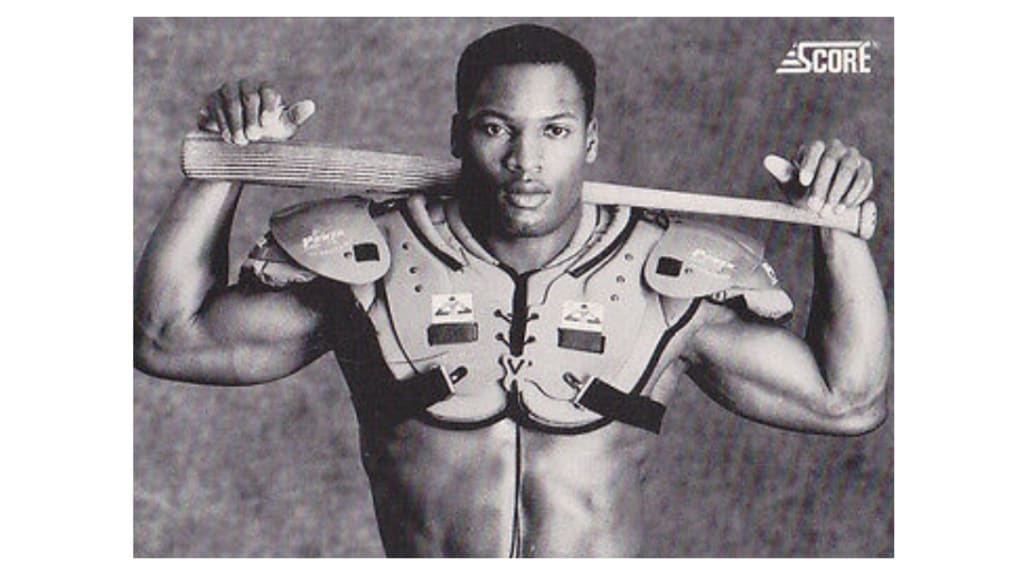
Bo Jackson, 1990 Score
There were four Bo Jackson cards in this 1990 Score set, but the one submitted by Ryan Fox from Quincy, Mass., Ken Cooper from Ventura, Calif., and Chris Hermansen from Suwanee, Ga., is easily the most famous.
The card depicts a shirtless Jackson wearing football shoulder pads and holding a baseball bat behind his head. It’s particularly notable for its simplicity, as it’s a black-and-white card that has no team logos and doesn’t even say Jackson’s name on the front.
A two-sport star, Jackson was at the height of his popularity at this point, playing in MLB and the NFL and starring in Nike’s “Bo Knows” advertising campaign, making him one of the most recognizable athletes on the planet.
“I bought this card as a kid and always liked how it looked,” Hermansen wrote. “I loved watching Bo play as a kid and had a pair of his Nike cross-training shoes.”
Jackson made the All-Star team with the Royals in 1989 and the Pro Bowl with the Raiders the following season, but his football career came to an end when he injured his hip in an NFL playoff game in January '91. Jackson was released by the Royals a few months later.
He subsequently signed with the White Sox but appeared in just 23 games during the 1991 season, then missed all of '92 before playing for the Sox in '93 and the Angels in '94, his final season.
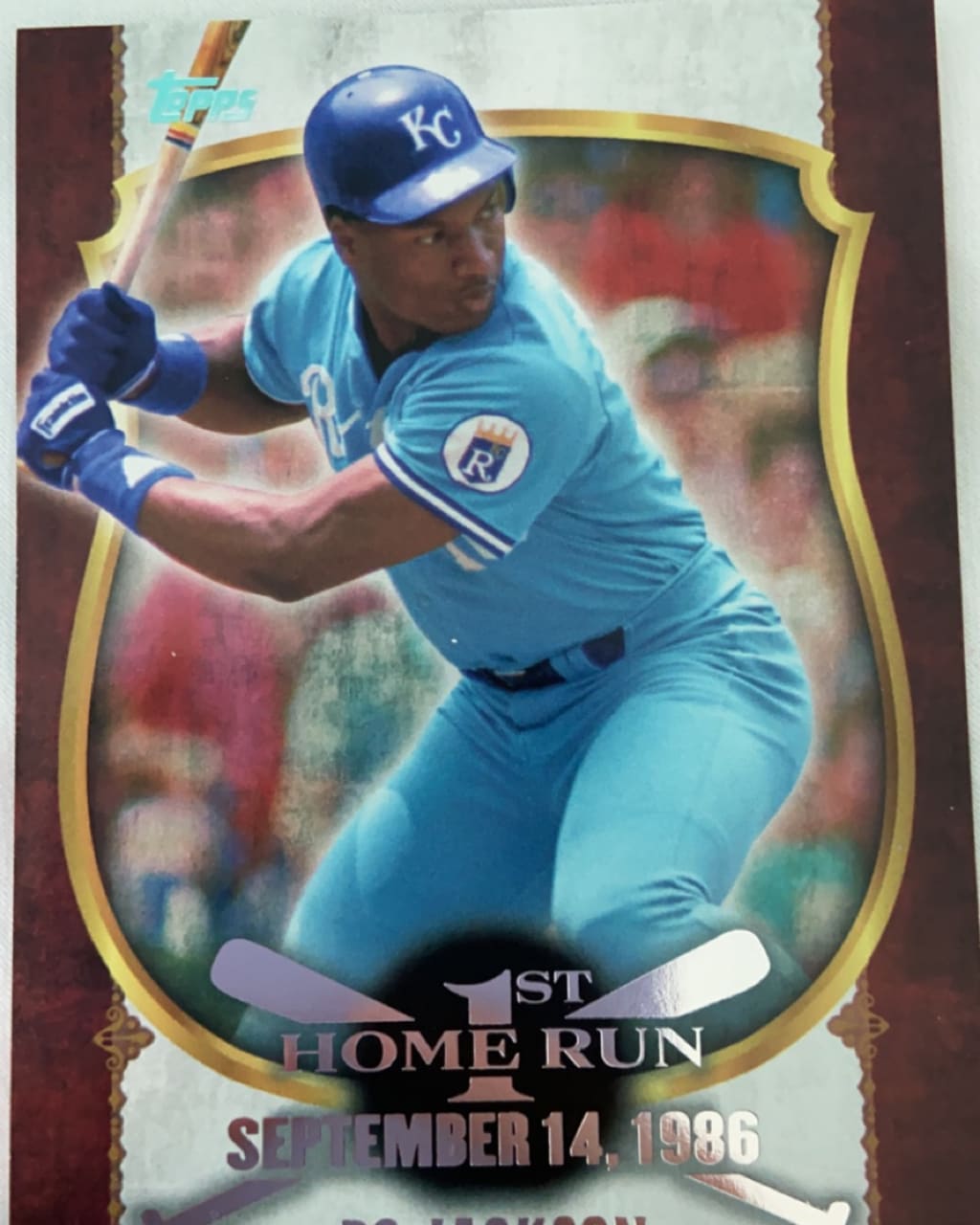
Bo Jackson, 2015 Topps First Home Run insert
Jackson captured our awe with his two-sport stardom, and the milestone of his first Major League home run is a very cool moment to remember. We get that here with this beautiful Topps insert, commemorating that first homer, which came on Sept. 14, 1986, in the first game of a doubleheader against the Mariners.
Jackson would hit 140 more homers in his big-league career, and also thrill football fans with his exploits as a running back in the NFL. Unfortunately, injuries shortened his career in both sports. Still, we can look back and marvel at the tremendous athlete Jackson was, one capable of doing what seemed to be superhuman.
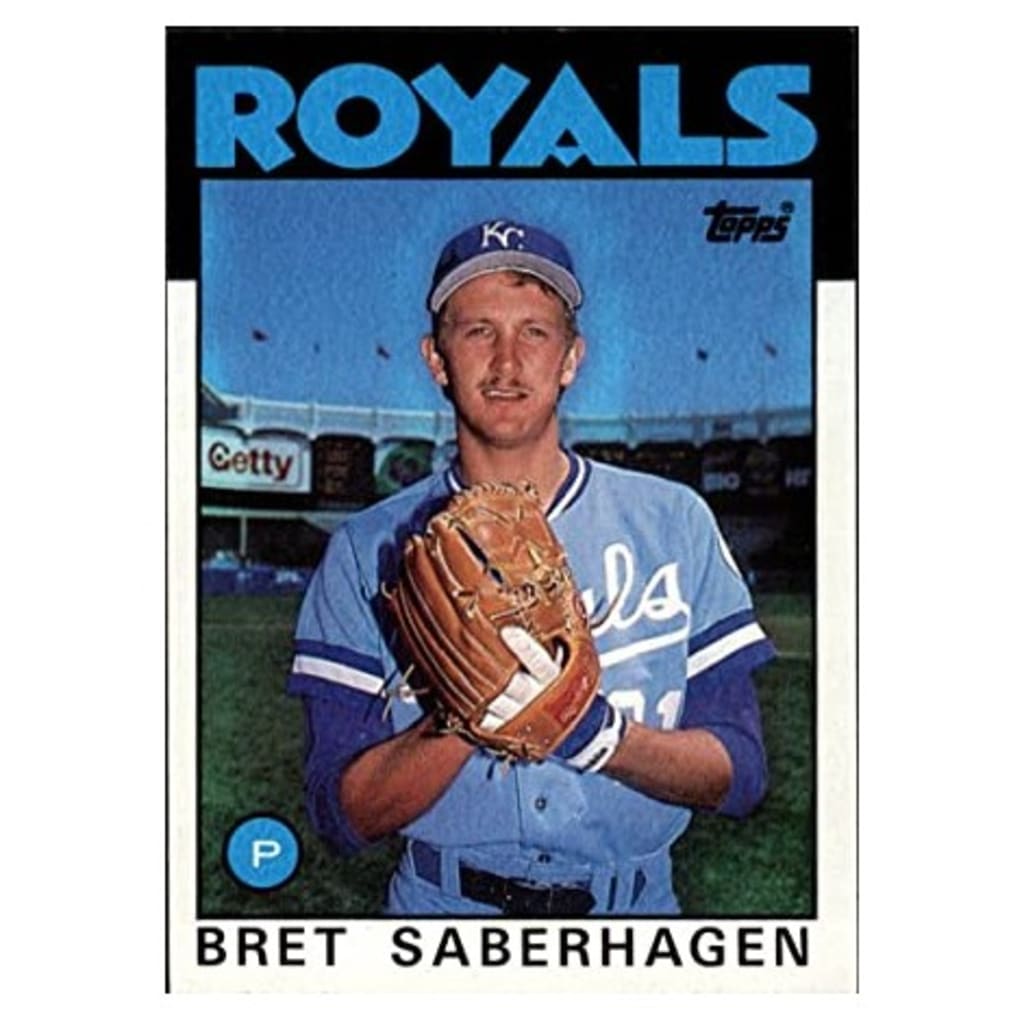
Bret Saberhagen, 1986 Topps
Presumably, this was a popular card in the Kansas City area in 1986.
Saberhagen was masterful the year before, winning the American League Cy Young Award and the World Series MVP Award as the Royals were crowned champions for the first time in franchise history.
The photo was clearly snapped at Yankee Stadium and shows Saberhagen wearing the Royals’ classic powder blue uniform as well as a batting glove on his left hand. We couldn’t find any evidence of Saberhagen wearing a batting glove while pitching, so it’s unclear why he has one here. -- Thomas Harrigan
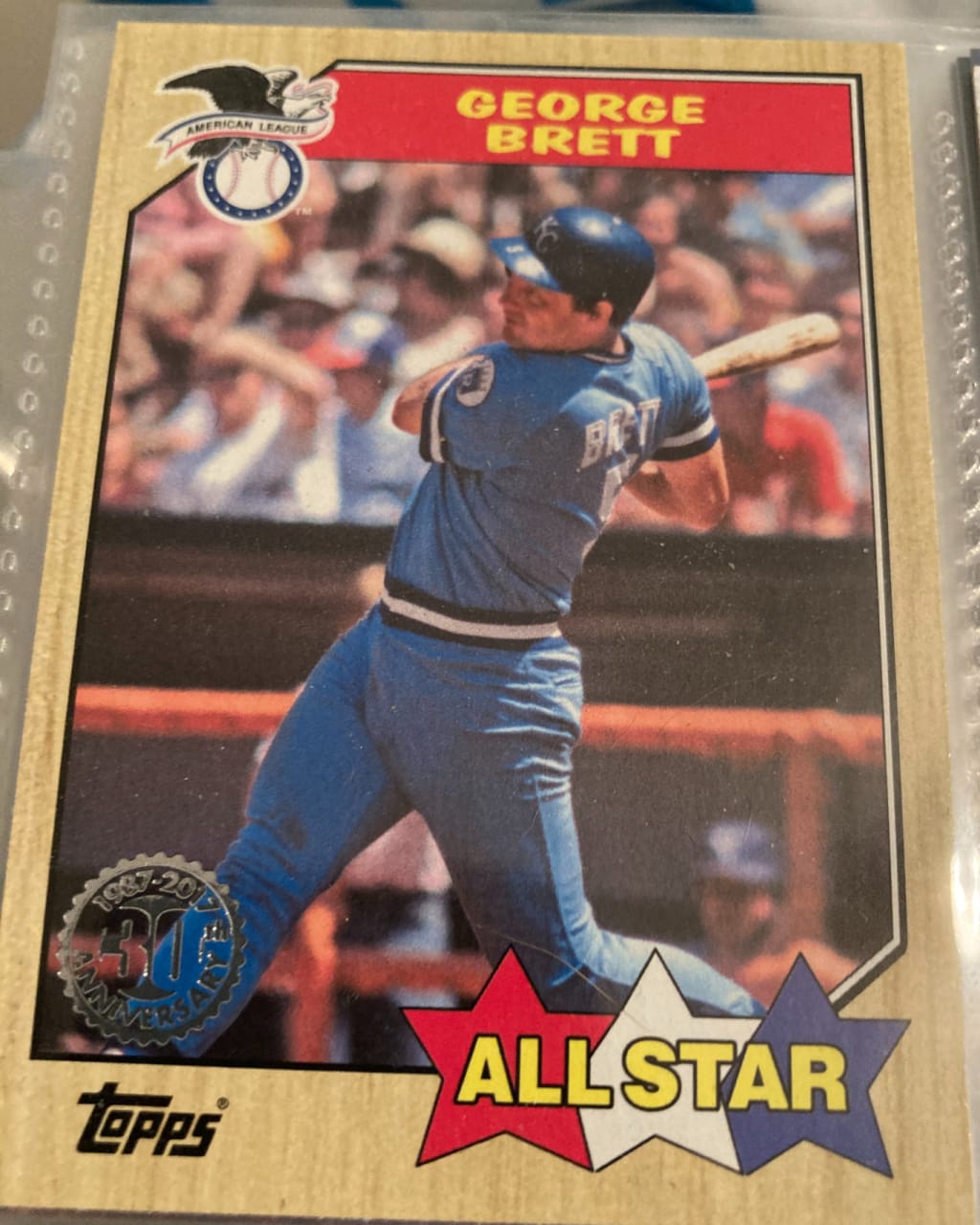
George Brett, 2017 Topps All-Star insert
One of the great concepts Topps came up with recently is the throwback card to years with popular designs, and the 1987 wood-grain-border look is arguably the most popular of them all. That's what we have with this Brett All-Star card, part of a special insert set celebrating the 30th anniversary of that year's set.
With the greatest Royal of them all finishing the follow-through of one of the greatest swings in baseball history, along with the tremendous old-school design, it doesn't get much better for the Royals fan who pulls this card from a pack. -- Manny Randhawa
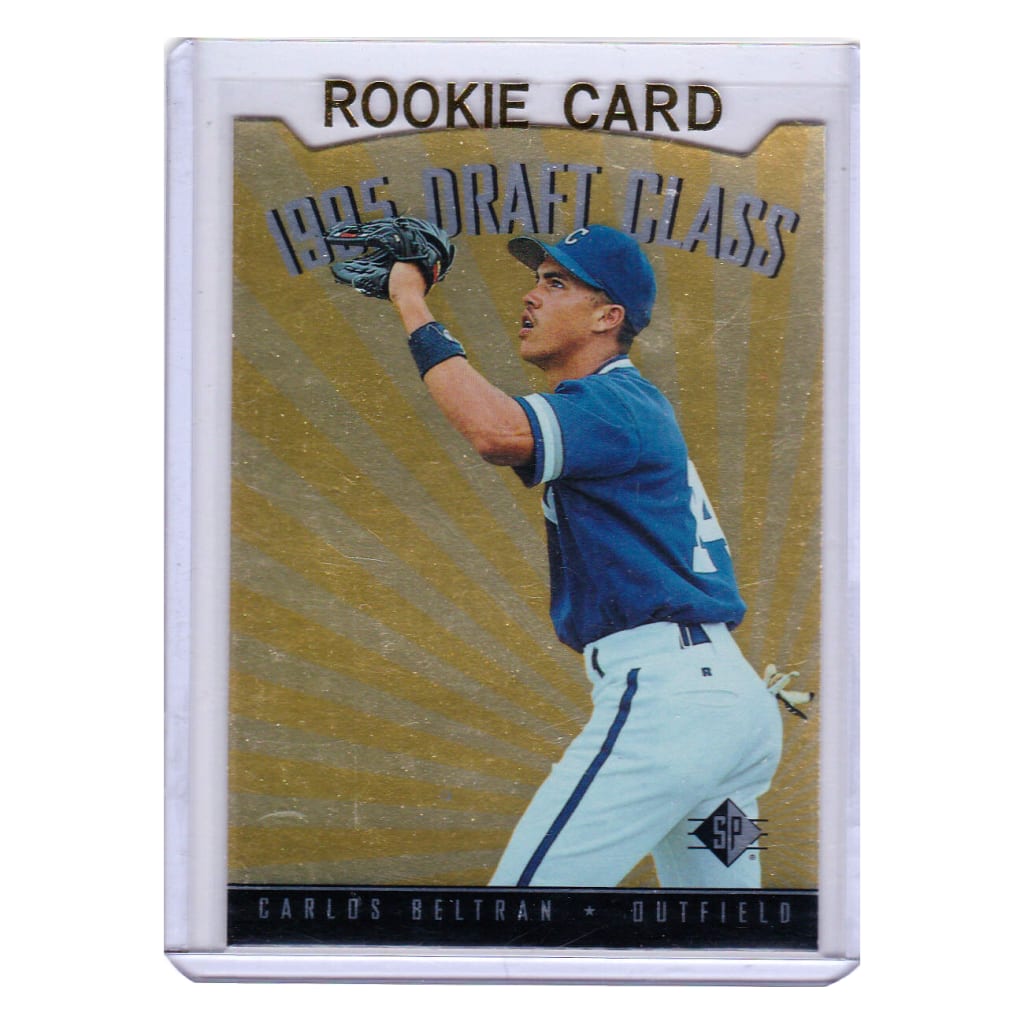
'90s throwback: Carlos Beltrán, 1995 SP Top Prospects
The SP baseball cards are already such a '90s brand (made by Upper Deck). This rookie card of Beltrán has that loud '90s style of baseball card design, too.
And there's Beltrán as a young Royals outfielder who had just been drafted as an 18-year-old out of high school in Puerto Rico. A few years later, he was the AL Rookie of the Year after a 22-home run, 27-steal season in 1999.
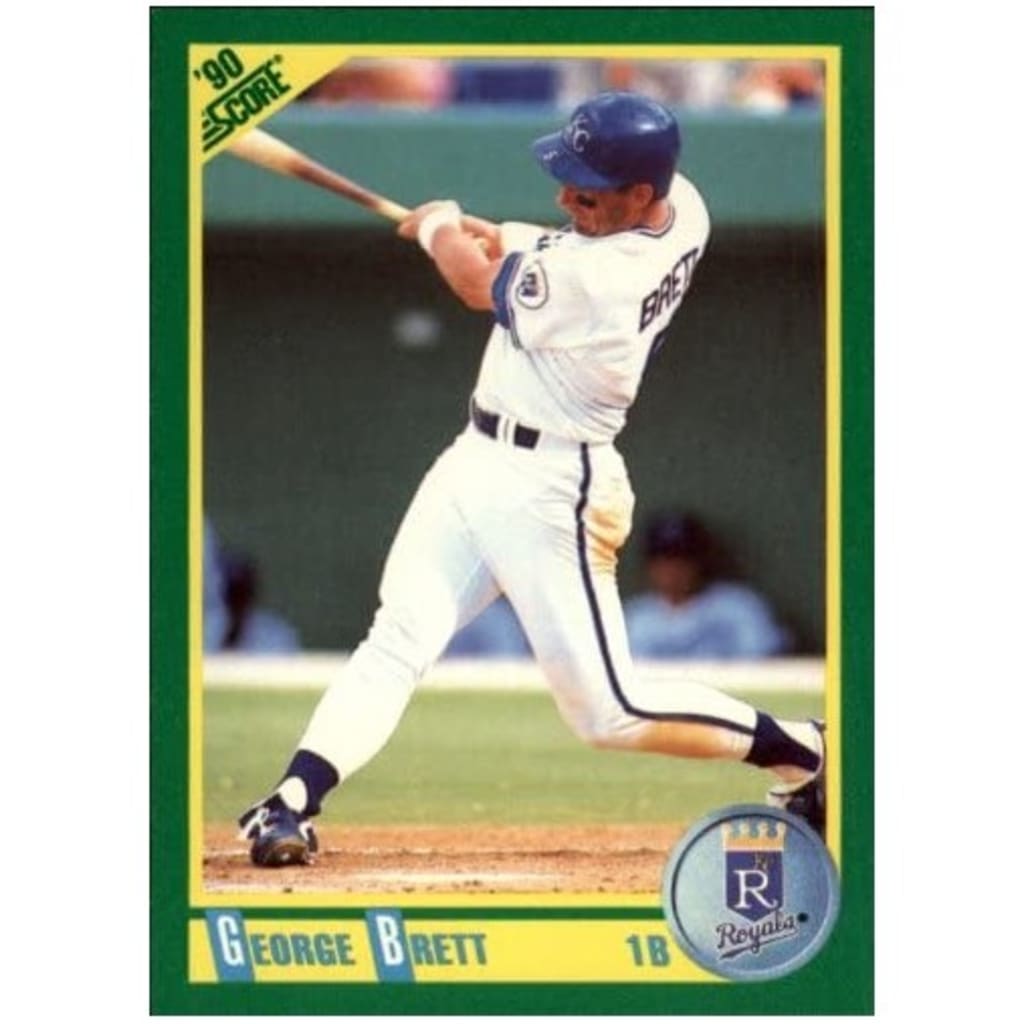
George Brett, 1990 Score
Unsurprisingly, there were a lot of different Brett submissions from Royals fans in our survey.
The Hall of Famer's card in the 1990 Score set was chosen by Eric Pitt of Tualatin, Ore., who wrote:
"Just a great image of a powerful swing. So many good swing fundamentals to look at. You can visualize the ball soaring based on the power captured on the card."
Although he was 37, Brett remained an elite hitter in 1990, winning the last of his three batting titles and leading the Majors with 45 doubles. -- Thomas Harrigan

Gaylord Perry, 1984 Fleer
Perry played for eight different clubs during his 22-year Hall of Fame career, but he was only with Kansas City for part of one. And that one happened to be his last, in 1983.
Here we see him pictured with another Hall of Famer, George Brett, who is perhaps the most recognized Royal of them all.
And what’s even better? They’re laughing with a bat and some pine tar after the famous “Pine Tar Incident” of July 24, 1983. That’s when Brett homered against the Yankees in New York, and Yankees manager Billy Martin had the umpires check the bat Brett used for an illegal amount of pine tar.
The home run was initially nullified and Brett was called out. Brett sprinted out onto the field in a rage, cementing an iconic image in baseball history. Meanwhile, Perry tried to abscond with the evidence, though he was stopped and the bat was returned to the umpires. -- Manny Randhawa

"Royals Sweep Yankees," 1981 Topps
George Brett stands alone in the center of this card, swinging the Royals past the Yankees and into the World Series.
Kansas City swept New York in the 1980 ALCS, one of the favorite baseball memories for Mark Patton of Independence, Mo., who sent in his card, signed by Brett himself … and chewed on by his dog, Wilson.
"I'm a huge longtime Royals fan," he writes. "We battled the Yankees through the 1970s, finally breaking through in 1980 and going to the World Series. For years I treasured my Topps card proving we could beat the New York Yankees and go to the World Series. Even had my favorite Royal, George Brett, sign it for me. Then I adopted a puppy named Wilson. Wilson's really developed a taste for my Topps card, too!"

Freddie Patek, 1979 Topps
One of the great elements of a baseball card survey is that there are so many great stories as to what makes a card memorable or valuable to a particular person. In the case of Matthew from Detroit, who submitted this Freddie Patek card, the value derives from what it represents both in terms of life lessons and family ties.
“I was 9 years old during the 1978 ALCS,” Matthew wrote. “We weren't Royals fans, but when Patek cried alone in the dugout after the Royals lost to the Yankees, my dad made a comment about Patek. I don't remember it exactly, but it had the effect of letting me know it was OK for grown-ups to cry. I made sure I traded for the Patek card the next season. I looked up to Patek and my dad for that. Still do.”
Patek was a three-time All-Star shortstop for the Royals, but not necessarily a household name outside of Kansas City. But when it comes to cherished baseball cards, that really doesn’t matter. There’s far more meaning to this one than any stats on the back could provide. -- Manny Randhawa
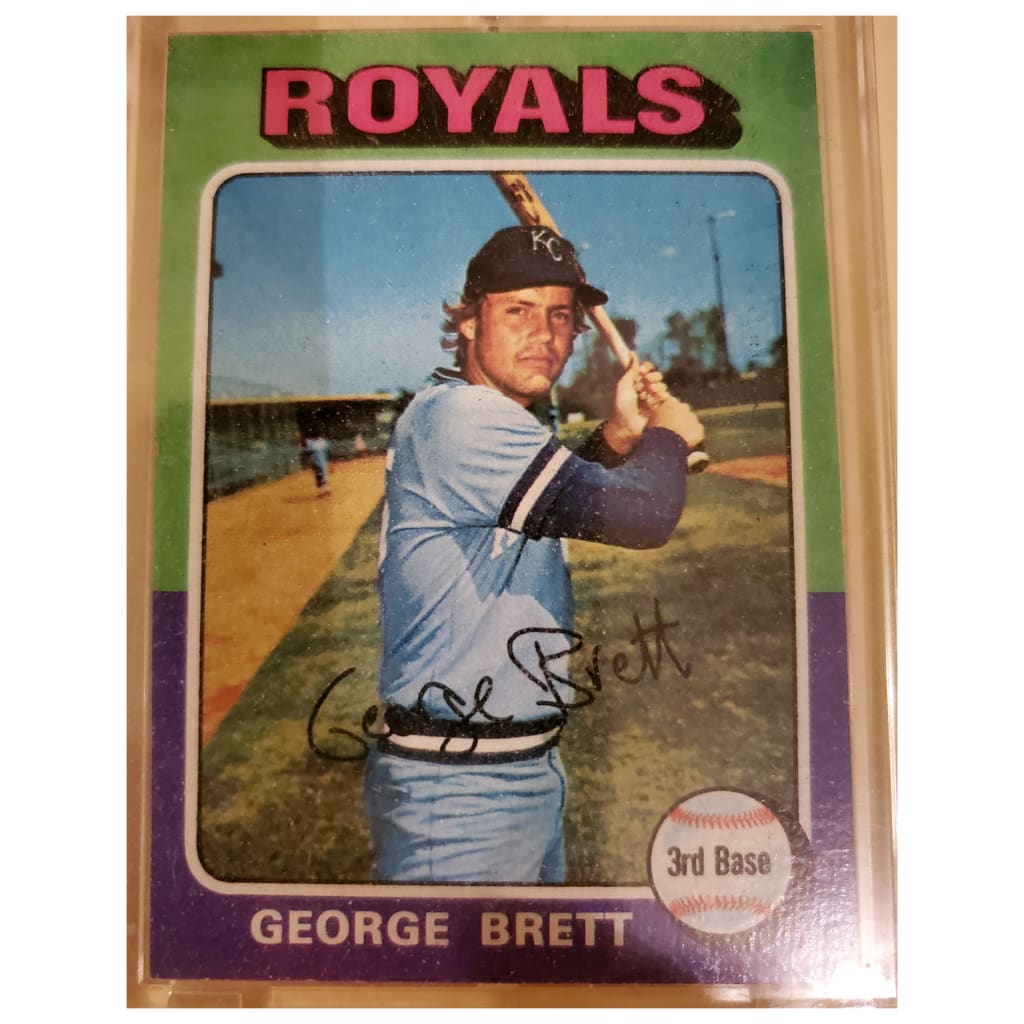
Iconic Royals rookie card: George Brett, 1975 Topps
For the Royals, it doesn't get any more classic than a George Brett rookie card.
The franchise icon, then only 22 years old, poses in his batting stance and light blue Kansas City uniform. On the card, Brett's signature is scrawled across his midsection.
This card was submitted by longtime MLB.com editorial producer Mike Weilamann, who writes, simply: "I became a fan because of No. 5."

